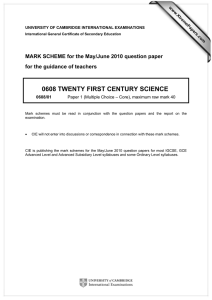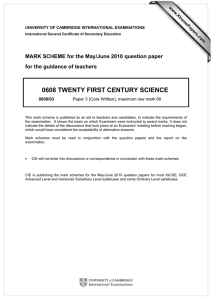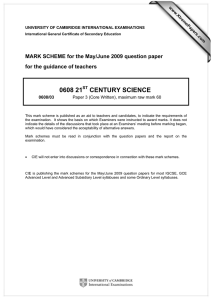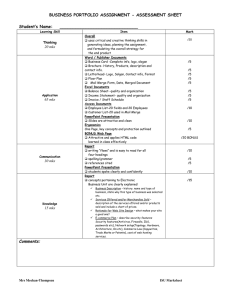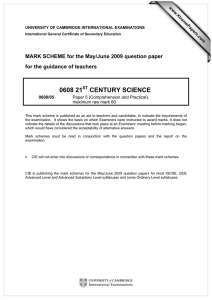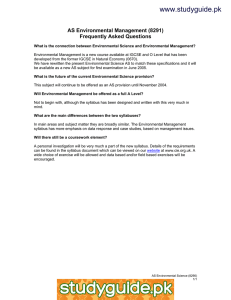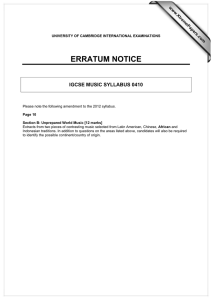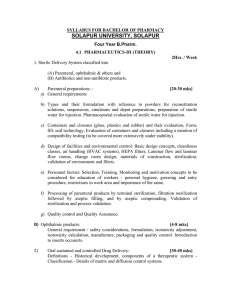0608 TWENTY FIRST CENTURY SCIENCE for the guidance of teachers
advertisement
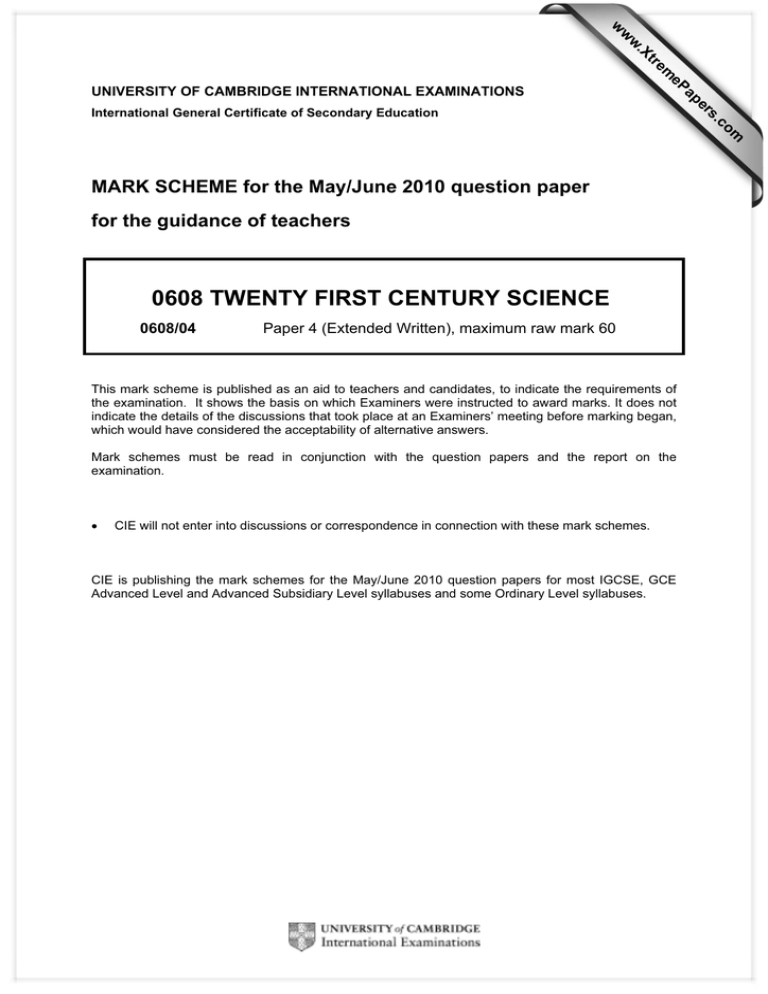
w w ap eP m e tr .X w UNIVERSITY OF CAMBRIDGE INTERNATIONAL EXAMINATIONS for the guidance of teachers 0608 TWENTY FIRST CENTURY SCIENCE 0608/04 Paper 4 (Extended Written), maximum raw mark 60 This mark scheme is published as an aid to teachers and candidates, to indicate the requirements of the examination. It shows the basis on which Examiners were instructed to award marks. It does not indicate the details of the discussions that took place at an Examiners’ meeting before marking began, which would have considered the acceptability of alternative answers. Mark schemes must be read in conjunction with the question papers and the report on the examination. • CIE will not enter into discussions or correspondence in connection with these mark schemes. CIE is publishing the mark schemes for the May/June 2010 question papers for most IGCSE, GCE Advanced Level and Advanced Subsidiary Level syllabuses and some Ordinary Level syllabuses. om .c MARK SCHEME for the May/June 2010 question paper s er International General Certificate of Secondary Education Page 2 Mark Scheme: Teachers’ version IGCSE – May/June 2010 Expected Answers 1 (a) (b) Mks Additional Guidance [2] Any two (ii) 25+23+26+26/4; = 25; [2] Allow one mark for 23 (i) the mean of metal B/66 is not within the range of metal A/the mean of metal A/25/23 is not within the range of metal B; [1] (ii) depth of dent is smaller for metal A; the harder the metal the less the depth of the dent; [2] [7] Expected Answers (a) Paper 04 (i) it gives a more reliable best estimate; it allows outliers to be found and ignored; one sample may be faulty; one experiment may be in error; Total 2 Syllabus 0608 Mks Additional Guidance [2] (i) one carbon dioxide for 1 mark; two water for second mark; (b) (ii) photosynthesis; dissolving in rain/seas; [2] (i) S + O2 SO2; [1] (ii) sulfur dioxide reacts with water and oxygen in the air; [1] Total [6] Expected Answers 3 Mks (a) plants need nitrogen to make protein; crops take nitrogen from the soil; no fertiliser is added to put the nitrogen back; [3] (b) abandoned areas cannot be used again; eventually all of forest is used up; [2] (c) in developed countries pesticides are used; farmers in developing countries cannot afford pesticides/pesticides may not be available; [2] Total [7] © UCLES 2010 Additional Guidance Climatic differences acceptable: factor (1) development (1) Page 3 Mark Scheme: Teachers’ version IGCSE – May/June 2010 Expected Answers 4 Syllabus 0608 Mks Paper 04 Additional Guidance (a) one from mother and one from father; [1] (b) gene on Y chromosome; [1] Allow description of e.g. X + X = girl, X + Y = boy [2] One mark for parent genotypes (c) (i) MOTHER X X X XX XX Y XY XY One mark for correct outcomes FATHER (d) (ii) 50% / 0.5 / ½ / 1 in 2; [1] (i) Ellen; [1] (ii) Chipo; [1] (iii) Amir; [1] Total [8] Expected Answers 5 Mks (a) chemicals; can kill bacteria/fungi; [2] (b) to prevent bacteria becoming resistant; [1] (c) Additional Guidance (i) increase in % of bacteria not affected; faster increase between 1940 and 1950/steadier increase now; [2] Must describe pattern of increase for second mark (ii) mutation in genes of bacteria; resistance passed onto next generation; [2] Allow explanation of sudden increase and then slower increase e.g. new antibiotic at start Total [7] © UCLES 2010 Page 4 Mark Scheme: Teachers’ version IGCSE – May/June 2010 Expected Answers 6 (a) (b) Mks nervous is electrical whereas hormone is chemical; nervous is faster than hormonal/ora; nervous are shorter lived response/ora; [1] (ii) D and E; [1] (iii) C; [1] Paper 04 Additional Guidance Any two [5] Expected Answers Mks Additional Guidance (a) clouds of dust produced (1); blocked out Sun’s radiation (for a long time) (1); cooled Earth below temperature at which they could survive (1); plants to feed (some of) them died due to darkness (1) [2] Any two points. Ignore any strictly local effects, e.g. blast (b) A, D and E [1] In any order. All 3 and no others for 1 mark. (c) data of extinctions not precise enough (1); fossil record not complete (1); may be other data not yet discovered (e.g. asteroid craters, lava flows) (1); other theories may be possible (1); scientists tend to stick with accepted theory (1); [2] First mark for clear indication of reason and second for explanation /clarification Total [5] Expected Answers 8 [2] (i) B; Total 7 Syllabus 0608 Mks (a) ionise/split up molecules (1); these ions/molecule fragments react chemically (1); consequent damage to cell can kill cell/cause cancer (1); [2] (b) ozone molecules absorb UV and are chemically changed (1); these changes are reversible and ozone is restored (1); [2] (c) Additional Guidance Any two points (i) Carl; [1] (ii) Abby, Barry and Carl; [1] All three and NOT Dana for the mark. (iii) Abby and Barry; [2] One mark each. Subtract one mark for each extra tick. Total [8] © UCLES 2010 Page 5 Mark Scheme: Teachers’ version IGCSE – May/June 2010 Expected Answers 9 Syllabus 0608 Mks Additional Guidance All three (in any order) for two marks. At least two for one mark. Deduct one mark for each other fuel in list. (a) coal, gas and oil;; [2] (b) 410 EJ (allow 405 – 415 EJ); [1] (c) Total energy in range = above+30+30+3EJ = 473 EJ (Allow 470 – 480 EJ) (1); ¼ of this = 120 EJ while nuclear = 30 EJ so claim is false (1); [2] (d) Electrical energy = 56 - (17 + 9) = 30 MJ (1); efficiency = (30 / 56)×100 = 54% (1); [2] Total [7] Paper Total [60] © UCLES 2010 Paper 04 Ora e.g. nuclear = 30 GJ (1) so claim is false as gas/coal/oil alone > 3 × this (1)
